Characteristics of Spiral Patterns Formed by Coaxial Interference between Two Vortex Beams with Different Radii of Wavefront Curvatures
Abstract
:1. Introduction
2. Theoretical Analysis
3. Experiment Setup
4. Results and Discussion
4.1. Effects of Phase Difference between Two Interference Beams on Spiral Patterns
4.2. Effects of Wavefront Curvature Radii Relations between Two Interference Beams on Spiral Patterns
4.3. Spiral Patterns Formed by Coaxial Interference between Two Vortex Beams
5. Conclusions
Author Contributions
Funding
Conflicts of Interest
References
- Allen, L.; Beijersbergen, M.W.; Spreeuw, R.J.C.; Woerdman, J.P. Orbital angular momentum of light and the transformation of Laguerre-Gaussian laser modes. Phys. Rev. A 1992, 45, 8185–8189. [Google Scholar] [CrossRef]
- Bozinovic, N.; Yue, Y.; Ren, Y.; Tur, M.; Kristensen, P.; Huang, H.; Willner, A.E.; Ramachandran, S. Terabit-scale orbital angular momentum mode division multiplexing in fibers. Science 2013, 340, 1545–1548. [Google Scholar] [CrossRef] [Green Version]
- Vallone, G.; D’Ambrosio, V.; Sponselli, A.; Slussarenko, S.; Marrucci, L.; Sciarrino, F.; Villoresi, P. Free-space quantum key distribution by rotation-invariant twisted photons. Phys. Rev. Lett. 2014, 113, 060503. [Google Scholar] [CrossRef] [Green Version]
- Liu, Y.; Gao, C.; Wang, X.; Yang, H. Transverse mode multiplexing using the helical eigen-beams of orbital angular momentum. Opt. Commun. 2012, 285, 888–892. [Google Scholar] [CrossRef]
- Paterson, L.; MacDonald, M.P.; Arlt, J.; Sibbett, W.; Bryant, P.E.; Dholakia, K. Controlled rotation of optically trapped microscopic particles. Science 2002, 292, 912–914. [Google Scholar] [CrossRef] [PubMed]
- Tian, Y.; Wang, L.; Duan, G.; Yu, L. Multi-trap optical tweezers based on composite vortex beam. Opt. Commun. 2021, 485, 126712. [Google Scholar] [CrossRef]
- Lavery, M.P.J.; Speirits, F.C.; Barnett, S.M.; Padagett, M.J. Detection of a spinning object using light’s orbital angular momentum. Science 2013, 341, 537–540. [Google Scholar] [CrossRef] [Green Version]
- Toyoda, K.; Miyamoto, K.; Aoki, N.; Morita, R.; Omastu, T. Using optical vortex to control the chirality of twisted metal nanostructures. Nano Lett. 2012, 12, 3645–3649. [Google Scholar] [CrossRef] [PubMed]
- Ni, J.; Wang, C.; Zhang, C.; Hu, Y.; Yang, L.; Lao, Z.; Xu, B.; Li, J.; Wu, D.; Chu, J. Three-dimensional chiral microstructures fabricated by structured optical vortices in isotropic material. Light-Sci. Appl. 2017, 6, e17001. [Google Scholar] [CrossRef] [Green Version]
- Syubaev, S.A. Direct laser printing of chiral plasmonic nanojets by vortex beams. J. Phys. Conf. Ser. 2018, 951, 012025. [Google Scholar] [CrossRef]
- Babiker, M.; Andrews, D.L.; Lembessis, V.E. Atoms in complex twisted light. J. Opt. 2018, 21, 013001. [Google Scholar] [CrossRef]
- Ma, J.B.; Li, P.; Zhou, Z.H.; Wu, Z.K.; Gu, Y.Z. Interference patterns of two LG0l vortex beams for coaxial and off-axial superposition. In Proceedings of the First Optics Frontier Conference, Hangzhou, China, 8 June 2021; Volume 11850, p. 118501E. [Google Scholar]
- Choomdaeng, S.; Chattham, N.; Pattanapokratana, A. Characteristics of forklet fringes formed by two obliquely-incident vortex beams with different topological charge number. J. Phys. Conf. Ser. 2018, 1144, 012158. [Google Scholar] [CrossRef]
- Ohtake, Y.; Ando, T.; Fukuchi, N.; Matsumoto, N.; Ito, H.; Hara, T. Universal generation of high-order multiringed Laguerre-Gaussian beams by using a spatial light modulator. Opt. Lett. 2007, 32, 1411–1413. [Google Scholar] [CrossRef]
- Kurzynowski, P.; Borwinska, M.; Masajada, J. Optical vortex sign determination using self-interference methods. Opt. Appl. 2010, 40, 165–175. [Google Scholar]
- Zhang, S.; Li, P.; Wang, S.; Tan, J.; Feng, G.; Zhou, S. Ultrafast vortices generation at low pump power and shearing interferometer-based vortex topological detection. Laser Phys. Lett. 2019, 16, 035302. [Google Scholar] [CrossRef]
- Lan, B.; Liu, C.; Rui, D.; Chen, M.; Shen, F.; Xian, H. The topological charge measurement of the vortex beam based on dislocation self-reference interferometry. Phys. Scr. 2019, 94, 055502. [Google Scholar] [CrossRef]
- Khajavi, B.; Ureta, J.R.G.; Galvez, E.J. Determining vortex-beam superpositions by shear interferometry. Photonics 2018, 5, 16. [Google Scholar] [CrossRef] [Green Version]
- Kumar, P.; Nishchal, N.K. Modified Mach-Zehnder interferometer for determining the high-order topological charge of Laguerre-Gaussian vortex beam. J. Opt. Soc. Am. A 2019, 36, 1447–1455. [Google Scholar] [CrossRef]
- Wang, J.; Cao, A.; Zhang, M.; Pang, H.; Hu, S.; Fu, Y.; Shi, L.; Deng, Q. Study of characteristics of vortex beam produced by fabricated spiral phase plates. IEEE Photonics J. 2016, 8, 6500209. [Google Scholar] [CrossRef]
- Ma, J.B.; Li, P.; Zhou, Z.H.; Gu, Y.Z. Characteristics of fork-shaped fringes formed by off-axis interference of two vortex beam. J. Opt. Soc. Am. A 2021, 38, 115–123. [Google Scholar] [CrossRef] [PubMed]
- Guo, X.; Meng, Z.; Li, J.; Yang, J.Z.; Aili, M.; Zhang, A.N. The interference properties of single photon vortex beams in Mach-Zehnder interferometer. Appl. Phys. Lett. 2021, 119, 011103. [Google Scholar] [CrossRef]
- Lv, F.; Li, X.; Tai, Y.; Zhang, L.; Nie, Z.; Chen, Q. High-order topological charges measurement of LG vortex beams with a modified Mach-Zehnder interferometer. Optik 2015, 126, 4378–4381. [Google Scholar] [CrossRef]
- Guo, J.; Guo, B.; Fan, R.; Zhang, W.; Wang, Y.; Zhang, L.; Zhang, P. Measuring topological charges of Laguerre-Gaussian vortex beams using two improved Mach-Zehnder interferometers. Opt. Eng. 2016, 55, 035104. [Google Scholar] [CrossRef]
- Vickers, J.; Burch, M.; Vyas, R.; Singh, S. Phase and interference properties of optical vortex beams. J. Opt. Soc. Am. A 2008, 25, 823–827. [Google Scholar] [CrossRef] [PubMed]
- Pan, S.; Pei, C.; Liu, S.; Wei, J.; Wu, D.; Liu, Z.; Yin, Y.; Xia, Y.; Yin, J. Measuring orbital angular momentums of light based on petal interference patterns. OSA Continuum 2018, 1, 451–461. [Google Scholar] [CrossRef] [Green Version]
- Szatkowski, M.; Masajada, J.; Augustyniak, I.; Nowacka, K. Generation of composite vortex beams by independent spatial light modulator pixel addressing. Opt. Commun. 2020, 463, 125341. [Google Scholar] [CrossRef]
- Bazhenov, V.Y.; Soskin, M.S.; Vasnetsov, M.V. Screw dislocations in light wavefronts. J. Mod. Opt. 1992, 39, 985–990. [Google Scholar] [CrossRef]
- Basistiy, I.V.; Soskin, M.S.; Vasnetsov, M.V. Optical wavefront dislocations and their properties. Opt. Commun. 1995, 119, 604–612. [Google Scholar] [CrossRef]
- Bogatiryova, G.V.; Soskin, M.S. Detection and metrology of optical vortex helical wave fronts. Semicond. Phys. Quantum Electron. Optoelectron. 2003, 6, 254–258. [Google Scholar] [CrossRef]
- Padgett, M.; Courtial, J.; Allen, L. Light’s orbital angular momentum. Phys. Today 2004, 57, 35. [Google Scholar] [CrossRef]
- Jin, J.; Luo, J.; Zhang, X.; Gao, H.; Li, X.; Pu, M.; Gao, P.; Zhao, Z.; Luo, X. Generation and detection of orbital angular momentum via metasurface. Sci. Rep. 2016, 6, 24286. [Google Scholar] [CrossRef] [Green Version]
- Cui, S.W.; Xu, B.; Luo, S.Y.; Xu, H.Y.; Cai, Z.P.; Luo, Z.Q.; Pu, J.X.; Chávez-Cerda, S. Determining topological charge based on an improved Fizeau interferometer. Opt. Expr. 2019, 27, 12774–12779. [Google Scholar] [CrossRef]
- Ma, H.X.; Li, X.Z.; Tai, Y.P.; Li, H.H.; Wang, J.G.; Tang, M.M.; Wang, Y.S.; Tang, J.; Nie, Z.G. In situ measurement of the topological charge of a perfect vortex using the phase shift method. Opt. Lett. 2017, 42, 135–138. [Google Scholar] [CrossRef] [PubMed]
- Dwivedi, R.; Sharma, P.; Jaiswal, V.K.; Mehrotra, R. Elliptically squeezed axicon phase for detecting topological charge of vortex beam. Opt. Commun. 2021, 485, 126710. [Google Scholar] [CrossRef]
- Zhao, Q.; Dong, M.; Bai, Y.H.; Yang, Y.J. Measuring high orbital angular momentum of vortex beams with an improved multipoint interferometer. Photonics Res. 2020, 8, 745–749. [Google Scholar] [CrossRef]
- Yang, Y.J.; Zhao, Q.; Liu, L.L.; Liu, Y.; Liu, Y.D. Manipulation of orbital-angular-momentum spectrum using pinhole plates. Phys. Rev. Appl. 2019, 12, 064007. [Google Scholar] [CrossRef]
- Senthilkumaran, P.; Masajada, J.; Sato, S. Interferometry with vortices. Int. J. Opt. 2011, 2012, 1–18. [Google Scholar] [CrossRef]
- Yang, D.; Yang, Z.; Zhao, Z.; Liu, Z. Radius of curvature of spherical wave measurement based on vortex beam interference. Opt. Lasers Eng. 2021, 142, 106592. [Google Scholar] [CrossRef]
- Fraczek, E.; Popiolek-Masajada, A.; Szczepaniak, S. Characterization of the vortex beam by Fermat’s spiral. Photonics 2020, 7, 102. [Google Scholar] [CrossRef]
- Khonina, S.N.; Kotlyar, V.V.; Shinkaryev, M.V.; Soifer, V.A.; Uspleniev, G.V. The phase rotor filter. J. Mod. Opt. 1992, 39, 1147–1154. [Google Scholar] [CrossRef]
- Beijersbergen, M.W.; Coerwinkel, R.P.C.; Kristensen, M.; Woerdman, J.P. Helical-wavefront laser beams produced with a spiral phaseplate. Opt. Commun. 1994, 112, 321–327. [Google Scholar] [CrossRef]
- Hamazaki, J.; Mineta, Y.; Oka, K.; Morita, R. Direct observation of Gouy phase shift in a propagating optical vortex. Opt. Expr. 2006, 14, 8382–8392. [Google Scholar] [CrossRef] [PubMed]
- Baumann, S.M.; Kalb, D.M.; MacMillan, L.H.; Galvez, E.J. Propagation dynamics of optical vortices due to Gouy phase. Opt. Expr. 2009, 17, 9818–9827. [Google Scholar] [CrossRef] [PubMed]
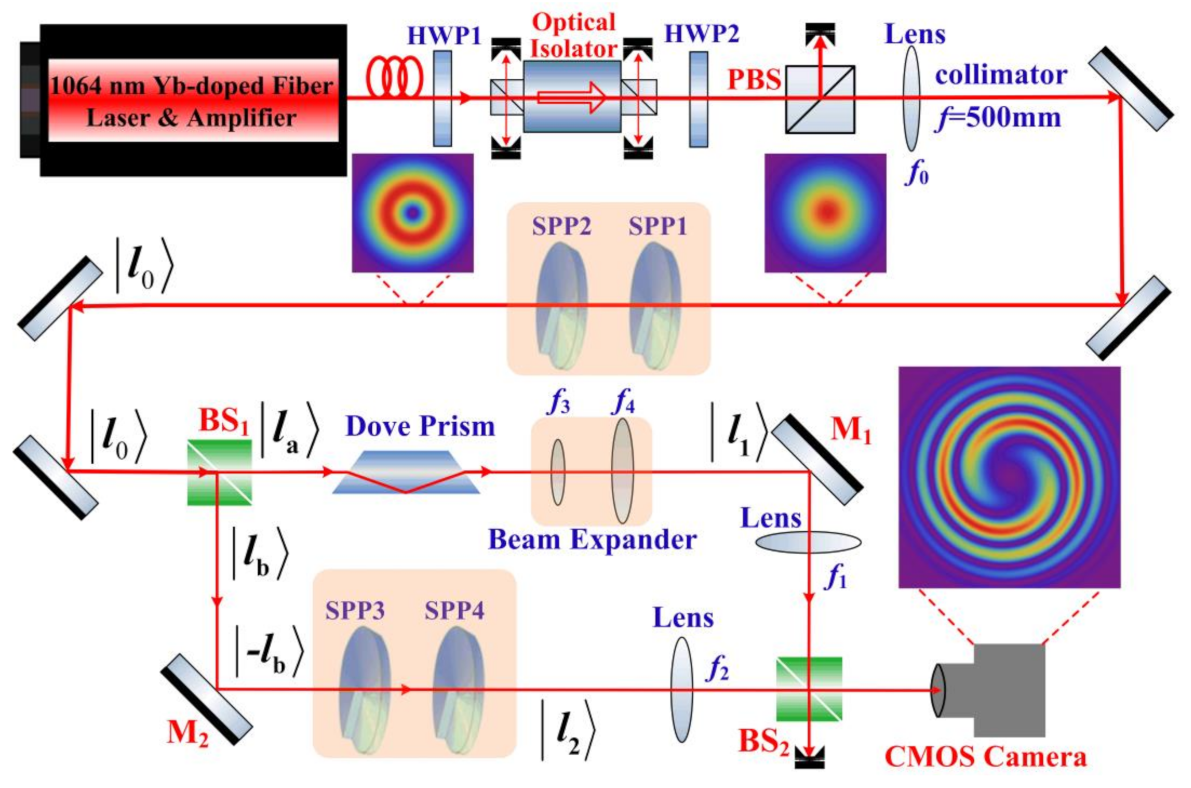
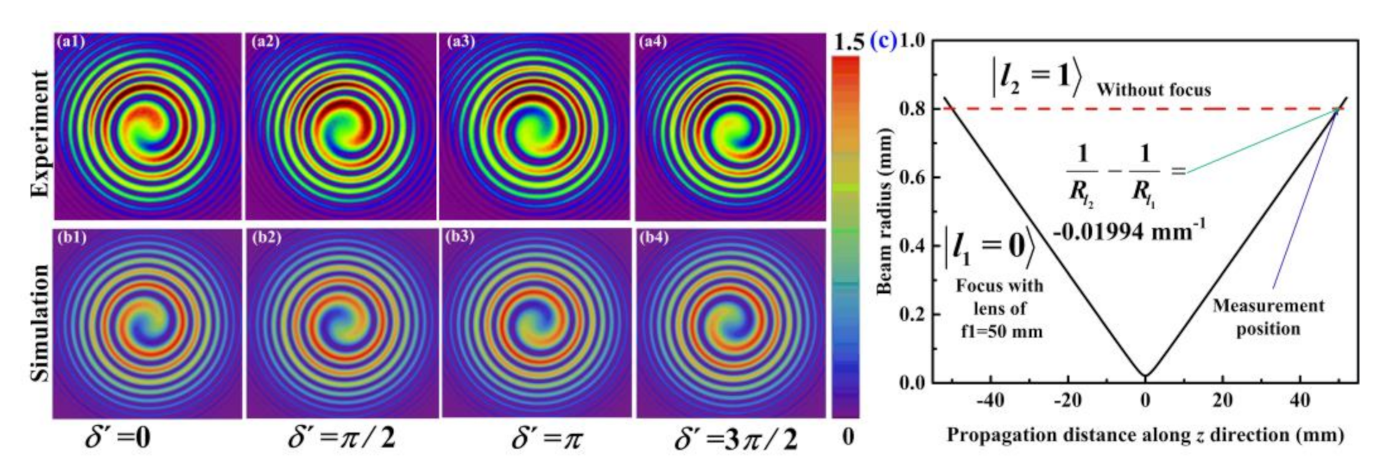
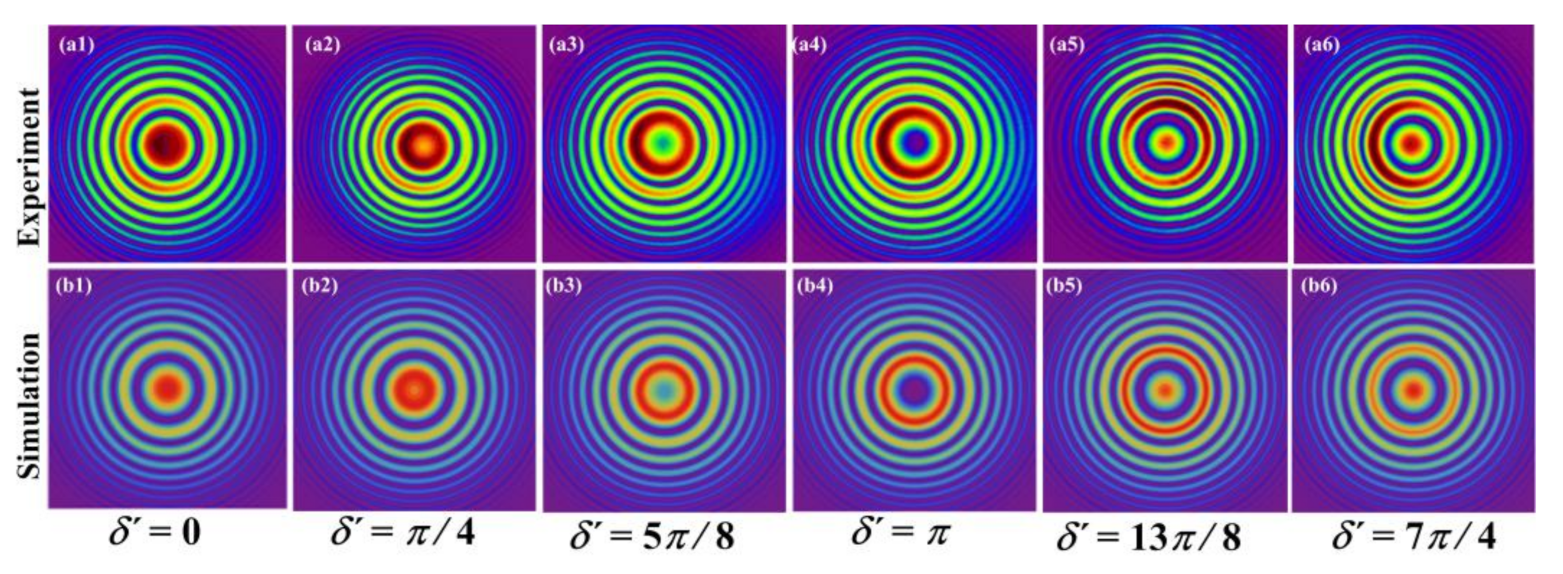

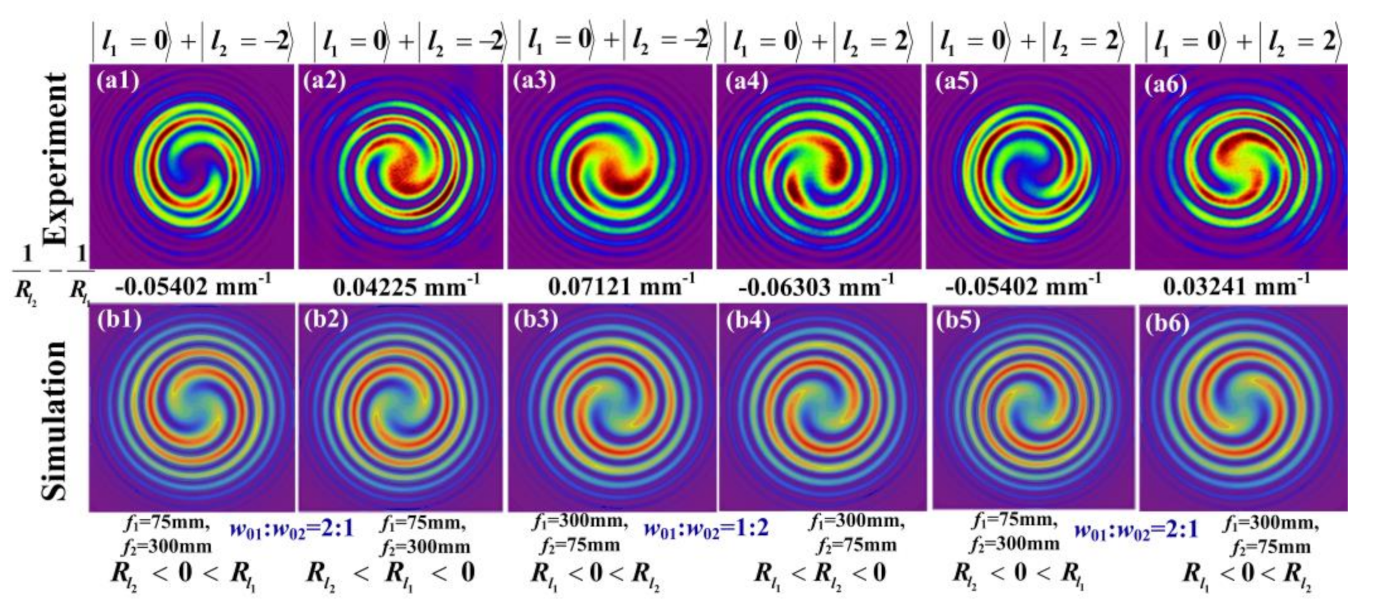

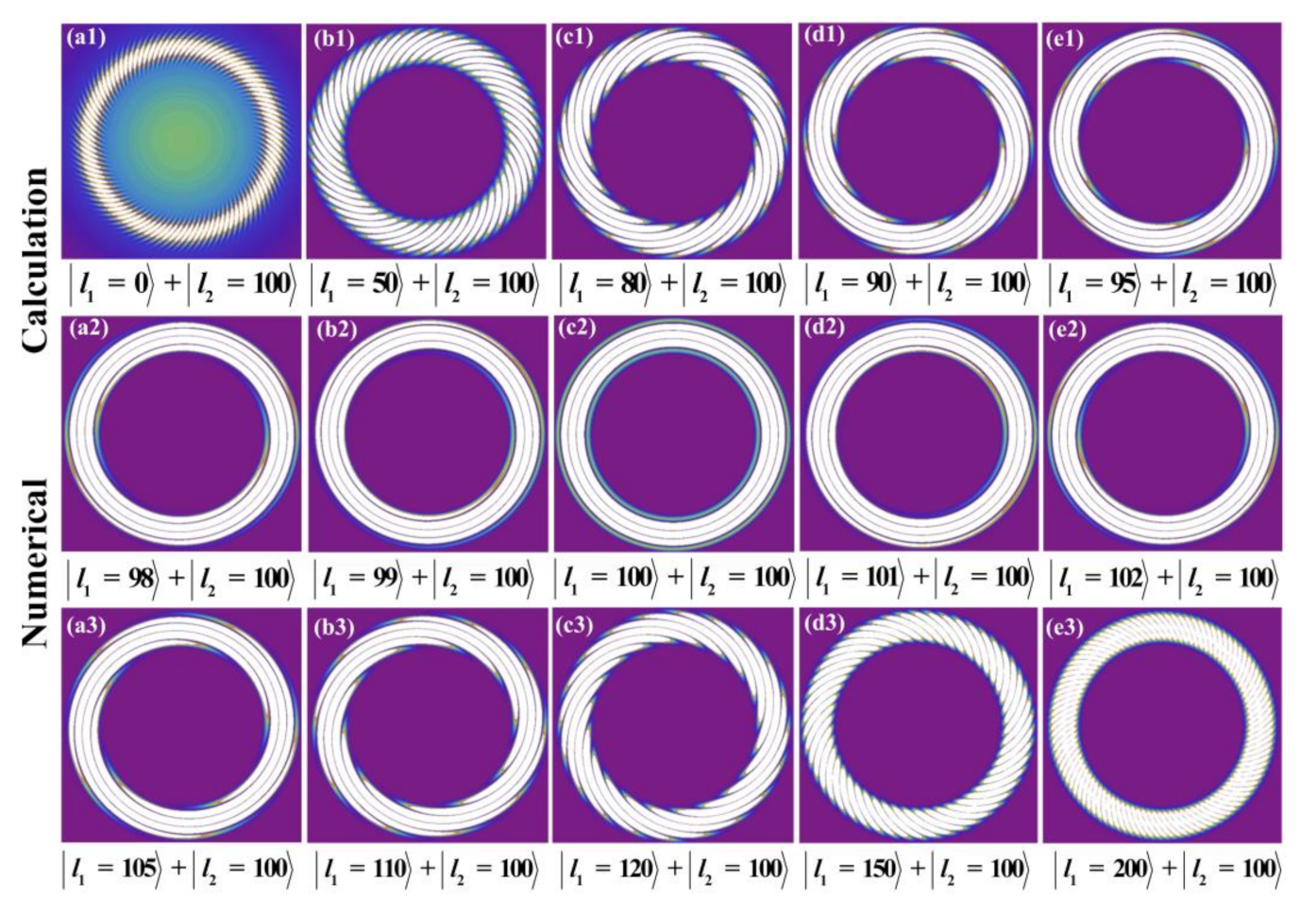
Publisher’s Note: MDPI stays neutral with regard to jurisdictional claims in published maps and institutional affiliations. |
© 2021 by the authors. Licensee MDPI, Basel, Switzerland. This article is an open access article distributed under the terms and conditions of the Creative Commons Attribution (CC BY) license (https://creativecommons.org/licenses/by/4.0/).
Share and Cite
Ma, J.; Li, P.; Gu, Y. Characteristics of Spiral Patterns Formed by Coaxial Interference between Two Vortex Beams with Different Radii of Wavefront Curvatures. Photonics 2021, 8, 393. https://doi.org/10.3390/photonics8090393
Ma J, Li P, Gu Y. Characteristics of Spiral Patterns Formed by Coaxial Interference between Two Vortex Beams with Different Radii of Wavefront Curvatures. Photonics. 2021; 8(9):393. https://doi.org/10.3390/photonics8090393
Chicago/Turabian StyleMa, Jingbo, Peng Li, and Yuzong Gu. 2021. "Characteristics of Spiral Patterns Formed by Coaxial Interference between Two Vortex Beams with Different Radii of Wavefront Curvatures" Photonics 8, no. 9: 393. https://doi.org/10.3390/photonics8090393
APA StyleMa, J., Li, P., & Gu, Y. (2021). Characteristics of Spiral Patterns Formed by Coaxial Interference between Two Vortex Beams with Different Radii of Wavefront Curvatures. Photonics, 8(9), 393. https://doi.org/10.3390/photonics8090393




